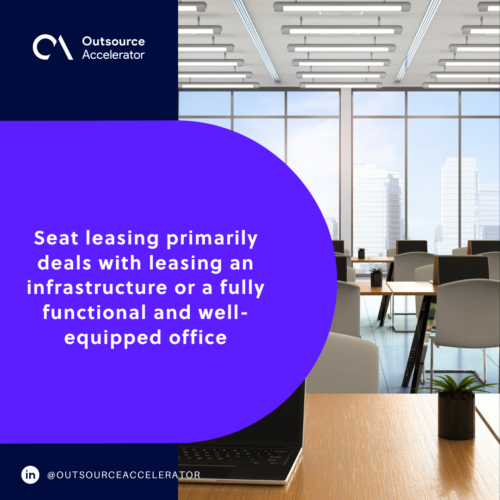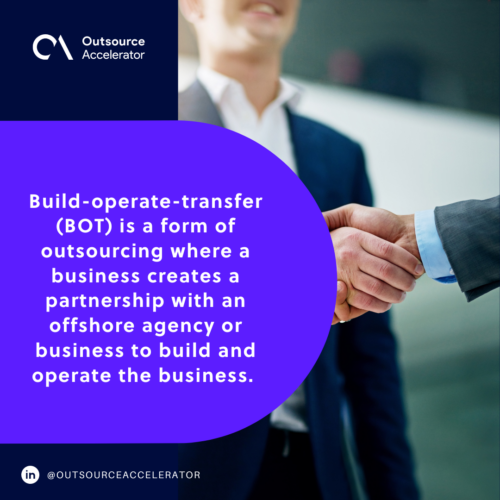Staff leasing vs. seat leasing vs. BPO vs. B-O-T

- Staff Leasing vs. Seat Leasing vs. BPO vs. B-O-T
As far as outsourcing is concerned, there are various choices available for businesses. Choosing the ideal model for a company would help to have better control in budget and costs, as well as the return on investment.
Outsourcing business processes can be classified on the outsourcing levels. It can either be staff leasing, seat leasing, comprehensive business process outsourcing, and B-O-T or Build-Operate-Transfer.
What is staff leasing?
Staff leasing is an outsourcing model where there is a contractual agreement for employee recruitment with a leasing company or a PEO (Professional Employer Organization). This is most suitable for companies that aim to hire in-house and remote workers with fewer risks and resources.
Here, the client can handpick people to be included in the team, but the entire hiring process will be co-managed by the service provider. The third-party company handles various business functions, such as administrative tasks and human resources.
Advantages and risks of staff leasing
Companies can enjoy several benefits from staff leasing.
- Shared risks in hiring. Clients won’t have to shoulder the responsibilities of handling employee benefits and compliances alone. Instead, they can share these hiring risks with their service providers.
- Access to top talents. Employers will have access to highly qualified talents, whether local or remote. Their service providers have years of expertise in
- Increased employee benefits. With staff leasing services, employees get to enjoy better benefits and incentives for the duration of their employment.
However, staff leasing as well brings risks for a business, especially when it comes to controlling. Since they share staff management with their service providers, all aspects should undergo with their service providers. This includes communications and control over employees.
This also affects their mindsets since companies could grow dependent on staff leasing.
What is seat leasing?
Seat leasing, on the other hand, primarily deals with leasing an infrastructure or a fully functional and well-equipped office. Seat leasing is an option for businesses that have small teams but don’t want to take a huge investment in building an office from scratch.
Companies have two options for seat leasing services: cold seats and warm seats. Cold seat leasing includes necessary office essentials like computer systems, internet connection, furniture, and other necessities.
Warm seat leasing, meanwhile, includes the option to hire an additional workforce for several functions, such as accounting and administrative work.
Advantages and risks of seat leasing
Arguably, seat leasing is the most common form of outsourcing in several destinations, including India and the Philippines.
Seat leasing is cheaper compared to singlehandedly renting out an office space. A 2017 data analysis in the United Kingdom states that companies are overpaying for workspaces for their employees because of their hidden costs. This includes the expenses of providing tools and equipment for them.
With seat leasing, they only have to pay monthly premiums for a fully furnished office space for their employees.
On the downside, most seat leasing offices have common pantries and utility services. While it can be beneficial to meet other employees from different companies, some clients might not be comfortable with this setup.
This as well poses difficulties in booking conference rooms, breakout areas, and other facilities for private use in case of meetings and exclusive company activities.

What is business process outsourcing (BPO)?
A comprehensive business process outsourcing pertains to having a long-term agreement and relationship between a company and an external service provider. The provider is required to handle business functions such as administration, content, delivery, and technology.
Business process outsourcing can be done in three ways: onshoring, nearshoring, and offshoring. Onshoring involves tapping a local service provider to do several functions for a company, including back- and front-office operations.
Clients looking to maximize their outsourcing benefits, meanwhile, seek out either nearshoring or offshoring. The only distinguishable difference between the two is their location, since nearshoring deals more with tapping nearby countries.
Advantages and risks of business process outsourcing
Companies choose outsourcing with the following benefits.
- Save on costs. Outsourcing helps clients save up to 70% on costs and maximize their profitability by managing an operation.
- Access to world-class employees. They won’t have difficulty in seeking suitable, high-quality talent for their companies when outsourcing a service.
- Tap a wider market. Companies can tap into a new market more easily since they can get to know its characteristics through their offshore and nearshore teams.
Though, business process outsourcing poses several risks to them as well. While onshoring helps in retaining their ‘local touch’ and identity, it offers fewer savings and incentives.
Nearshoring and offshoring, meanwhile, pose risks to data security and intellectual property. In offshoring, for instance, companies and service providers still find ways to increase their security and protect them from data breaches and malicious activities.
What is build-operate-transfer (BOT)?
Build-operate-transfer (BOT) is a form of outsourcing where a business creates a partnership with an offshore agency or business to build and operate the business.
During the building stage, the agency will build the business infrastructure from scratch, which already includes personnel, office space, licenses, and all essentials. At a later stage, once everything is ready, the business will be transferred to the owner.
In outsourcing, clients using BOT usually start with staff leasing or seat leasing, which will be transferred once they are ready to handle the team on their own.
BOT has different forms depending on the country the client will outsource to. For instance, India leans more on build-own-operate-transfer (BOOT) when outsourcing software development and IT services.

Advantages and risks of BOT
BOT only requires a short time of setup compared to building a new department from scratch. The outsourcing partner can share their knowledge and expertise in building an operation. This is most helpful for small businesses aiming to have offshore operations for the first time.
Further, companies can have lower building and operation risks since they get to co-manage their functions first with their service provider.
However, companies should plan firsthand which functions should undergo BOT. Once they absorbed a team, employees are now covered by the company’s long-term retention program. This is not ideal for dynamic teams that should be scaled down depending on demand.
The process of transition also means tedious documentations and higher charges on the client’s part. This is why companies should be prepared when deciding to transfer operations to their company.
Recognizing the pricing, labor costs, and internal revenues
One of the main reasons why businesses and companies outsource parts of their business processes is to save on costs and expenses while increasing sales at the same time.
Outsourcing price is usually the selling point in choosing where to outsource. However, before outsourcing a business function, it is important to specify what functions you want to outsource and the quality of output you are expecting.
It will help identify if outsourcing that function is as cost-effective as you realize compared to doing it in-house. Calculating the in-house costs of a business function you wish to outsource would also help you verify how much you are about to save.
Calculate both outsourcing costs and in-house costs, deduct the latter from the former and you will be able to derive your total cost savings.







 Independent
Independent




